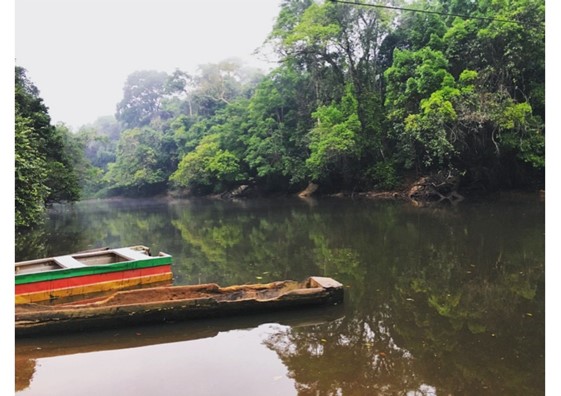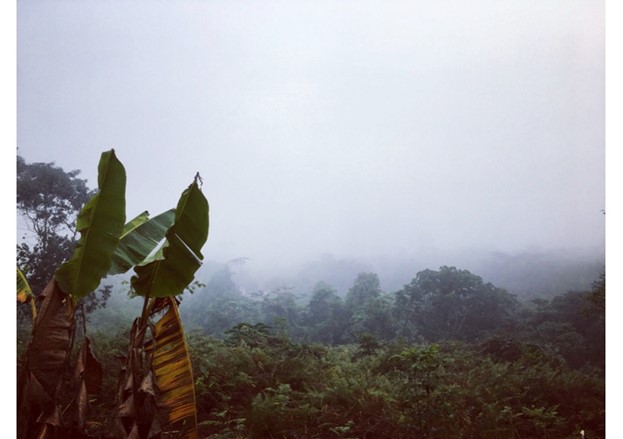University of Oxford
11a Mansfield Rd
OX1 3SZ
UK

Researchers from the Why Eat Wild Meat project, funded by the Darwin Initiative, have just published a new paper in Conservation Science and Practice on the drivers of wild meat preference in Cameroon, with important implications for the design of alternatives projects in rural areas.
Wild meat, also known as bushmeat, is an important source of food and income for millions pf people across the tropics, and in particular across Africa. However, hunting at unsustainable levels has clear negative impacts for both nature and for people, especially in rural areas where alternative sources of protein or income are often lacking. Where hunting is deemed to be illegal or unsustainable, ‘wild meat alternatives projects’ are often proposed as a strategy to try to steer people away from hunting or consuming wild meat in favour of other sustainably available sources of protein.

Houses in one of the study villages. Photo by Stephanie Brittain.
Alternatives projects are a favoured approach by conservation NGOs and national governments across Africa, and an estimated $2.2 million is being spent on alternatives projects each year. This is despite little evidence that these projects achieve their intended conservation objectives (e.g. stable or increased species populations, reduction in threats to species) or social objectives (e.g. diversified food and/or income sources, reduced risk to health by reducing sometimes dangerous hunting activities, increased time available for other activities). Failing to achieve these goals is a particularly poignant problem in areas with poor conservation legacies, where communities have felt repeatedly let down by conservation, for example through a failure to recognise people’s rights to land and resources, through to violent conflicts with Ecoguards, as highlighted here.
Why do people eat wild meat?
One reason projects may not achieve their intended goals is that they do not fully understand the factors that drive people to consume wild meat in the first place. For example, people may be consuming wild meat not out of necessity as is often assumed, but because they enjoy eating it, or because of other cultural drivers. Projects that are designed without a good grasp of the drivers of consumption result, at best, providing an additional source of food or income, rather than a replacement.
Therefore, identifying the drivers of preference is crucial to inform the design of alternatives projects, in particular those that try to provide an alternative source of protein. In an article published this week, the Why Eat Wild Meat project researchers present the results of our work in four rural villages adjacent to the Dja Faunal Reserve in southeast Cameroon. Our work aims to understand the importance of wild meat in people’s lives and explore the drivers and barriers that shape people’s food choices.

Pirogue crossing to reach the Dja Faunal Reserve and surrounding villages. Photo by Stephanie Brittain.
We found that wild meat is preferred to meat from domestic livestock or wild caught fish. The most commonly preferred species (porcupine and blue duiker) are relatively abundant, with the exception of pangolin, which is a globally endangered species, but which people reportedly prefer because of its good taste. Commonly cited drivers of preference include taste, perceived health benefits, and ease of access, while taboos related to the consumption of certain species by different groups of people (e.g. men and women, older and younger people, different ethnicities), as well as the bad taste and health concerns related to certain species played a strong part in species avoidance.
That people in rural Cameroon are making choices based on health and taste, rather than simply availability or cost, challenges the assumptions that often underpin many alternative meat projects. Wild meat consumption in rural Cameroon is not just about material wellbeing. Failing to account for these intangible components in alternatives project design could result in a failure to achieve the intended conservation and social outcomes.
We urge conservation practitioners developing wild meat alternative projects to recognise and account for the diverse, and often context-specific, drivers of wild meat consumption in the planning stages of project design, such as those set out in this practical guidance for wild meat alternative project design. We advise conservation policy makers to support and promote the use of participatory approaches to understand the drivers of consumption, the species consumed locally, and the challenges people face in shifting to other foodstuffs.
Given the renewed focus on the health and conservation implications of wild meat consumption following COVID-19, we expect the number of wild meat alternative projects to increase. Our findings will help guide projects aimed at reducing demand for wild meat in the Dja area, and we hope our approach will inform the baseline data collection for wild meat alternative projects more widely.

Read the article here: The drivers of wild meat consumption in rural Cameroon: Insights for wild meat alternative project design
Click here for more information and publications related to the Why Eat Wild Meat project.

